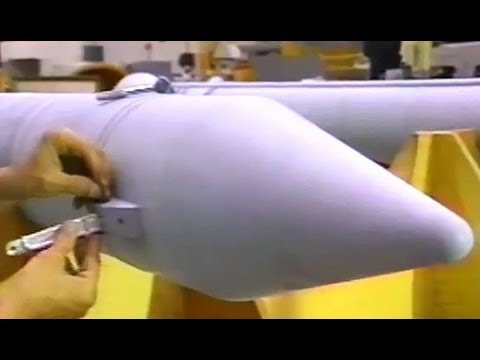more at
“This video explores the world of modeling at the NASA Johnson Space Center. Artisans create models, large and small, to help scientists and engineers make final design modifications before building more costly prototypes.”
Public domain film from NASA, slightly cropped to remove uneven edges, with the aspect ratio corrected, and mild video noise reduction applied.
The soundtrack was also processed with volume normalization, noise reduction, clipping reduction, and/or equalization.
A physical model (most commonly referred to simply as a model, however in this sense it is distinguished from a conceptual model) is a smaller or larger physical copy of an object. The object being modelled may be small (for example, an atom) or large (for example, the Solar System).
The geometry of the model and the object it represents are often similar in the sense that one is a rescaling of the other; in such cases the scale is an important characteristic. However, in many cases the similarity is only approximate or even intentionally distorted. Sometimes the distortion is systematic with e.g. a fixed scale horizontally and a larger fixed scale vertically when modelling topography of a large area (as opposed to a model of a smaller mountain region, which may well use the same scale horizontally and vertically, and show the true slopes).
Physical models allow visualization, from examining the model, of information about the thing the model represents. A model can be a physical object such as an architectural model of a building. Uses of an architectural model include visualization of internal relationships within the structure or external relationships of the structure to the environment. Other uses of models in this sense are as toys.
Instrumented physical models are the most effective way of investigating fluid flows such as around hydraulic structures. These models are scaled in terms of both geometry and important forces, for example using Froude number or Reynolds number scaling (see Similitude).
A physical model of something large is usually smaller, and of something very small is larger. A physical model of something that can move, like a vehicle or machine, may be completely static, or have parts that can be moved manually, or be powered. A physical model may show inner parts that are normally not visible. The purpose of a physical model on a smaller scale may be to have a better overview, for testing purposes, as hobby or toy. The purpose of a physical model on a larger scale may be to see the structure of things that are normally too small to see properly or to see at all, for example a model of an insect or of a molecule.
A physical model of an animal shows the animals physical composition without it walking or flying away, and without danger, and if the real animal is not available. A soft model of an animal is popular among children and some adults as cuddly toy.
A model of a person may e.g. be a doll, a statue, and in fiction a robotic humanoid, e.g. the mechas in the movie A.I..
A model is a 3D alternative for a 2D representation such as a drawing or photograph, or in the case of a globe, a 3D, undistorted alternative for a flat world map…
A scale model is a physical model, a representation or copy of an object that is larger or smaller than the actual size of the object, which seeks to maintain the relative proportions (the scale factor) of the physical size of the original object. Very often the scale model is used as a guide to making the object in full size. Scale models are built or collected for many reasons.
Professional modelmakers often create models for many professions:
– Engineers who require scale models to test the likely performance of a particular design at an early stage of development without incurring the full expense of a full-sized prototype.
– Architects who require architectural models to evaluate and sell the look of a new construction before it is built.
– Filmmakers who require scale models of objects or sets that cannot be built in full size.
– Salesmen who require scale models to promote new products such as heavy equipment and automobiles and other vehicles.
Hobbyists or amateur modelmakers make die-cast models, injection molded, model railroads, remote control vehicles, wargaming and fantasy collectibles, model ships and ships in bottles for their own enjoyment.
Scale models can also be objects of art, either being created by artists or being rediscovered and transformed into art by artists…

